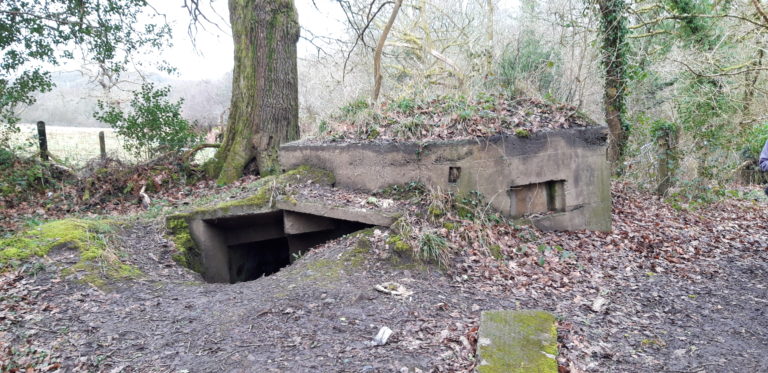Introduction
This was a defensive line running from Swansea Bay to the Loughor Estuary, which was included in the Severn Sub-Area Home Defence Scheme No 2 (reference WO 166/1314). It was one of many defensive stop lines across the UK constructed during World War II. It is not known whether records for the Gower Stop Line scheme survive, but they may be in The National Archives in Kew. It is unclear whether the structures were constructed in 1940 or in 1942-3. The following elements have been identified:
- Pillbox on the beach near the Mumbles Road/Sketty Lane junction (SS 627 915)
- Pillbox at the entrance to the civic amenity site, Ynys Newydd Road (west side) (SS 616 916)
- Pair of pillboxes on either side of the bridge over the cycle track, south-east of Killay station site (SS 60084 92146 north side; SS 60078 92107 south side)
These two pillboxes are both the polygonal Type 22 pillbox; they were intended to protect the northern approach to a bridge over the London Midland & Scottish Railway’s Clyne Valley line. The structure of the northern box has the remains of a Turnbull mount for a Vickers machine gun.
- Pillbox on top of the north-eastern embankment, south-east of the site of Killay station (SS 598 924)
- Pillbox near Clyne Cottages, Killay (SS 600 923)
- Pillbox near Gower Road bridge (north side) opposite the entrance to the Railway Inn, Killay (SS 598 924)
- Pillbox on Highland Terrace, Dunvant (east side) (SS 59639 93761)
A precast-concrete pillbox is a variant of the Type 22. The pillbox is hexagonal in shape, with loopholes in each wall. This variant is slightly unusual in that it does have an external blast wall protecting its entrance.
- Pillbox on the continuation of Highland Terrace, Dunvant (SS 59673 94273)
A precast-concrete pillbox, a variant of type 27, overlooking the former Penlan brickworks. This pillbox is built into the top of the slope and does not have any loopholes, just a slight chamber that can be reached via a flight of steps and an entrance tunnel. No central pedestal for a light anti-aircraft gun was present. Possibly used for observation only. A very unusual location as type 27s are mostly built around or near airfields.
- Spigot mortar emplacement, above the site of Dunvant brickworks (SS 59579 94074)
A good example of a standard 29mm spigot mortar emplacement comprising two ammunition lockers and concrete ‘thimble’. The monument is located on the site of a steep incline overlooking the former London Midland and Scottish Railway, deployed by the Home Guard during WWII as an anti-invasion measure.
The stop line also includes a pillbox beside the LMS line between Dunvant and Gowerton and anti-tank cubes near Gowerton on the marsh, north of Penclawdd Road (B4295.)
Other elements of the Gower Stop Line formerly included a pillbox on the LMS railway bridge across Mumbles Road at Blackpill (demolished in the 1960s?) and a spigot mortar emplacement (now destroyed) at the railway bridge over the Victoria Road, Gowerton (B4925).

